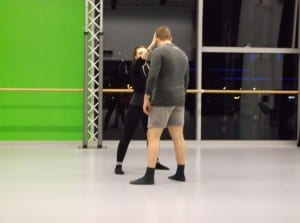Daly describes movement as: ‘There is nothing so powerful and extraordinary but at the same time so mundane and overlooked as movement.’ (Daly, 1988, 41). This influences the choreography process for a choreographer due to the freedom and expression that comes with movement naturally. So once meaning is put to the movement can create something beautifully visual and meaningful within a performance.
Throughout the process of choreography includes:
- Design and Visual Ideas
- Clear communication of Movement
- Angles and Audience views
Throughout my process of choreographer i have been abiding by these three points. The work of a choreographer starts with the design and ideas from the director. Then I must work and design ideas yet keeping in mind the space we have, the costumes that will be worn and possible obstructions to look out for. Company members have expressed to me that they are not “movement based” which is why i must take the time to break down my ideas and express them clearly so they understand. ‘Choreographers in community theatre must often work with non-dancers, or dancers with limited experience, as well as those who have had considerable training. This can mean extra rehearsal time, which must be planned for.’ (American Association of Community Theatre, 2017).

Photo Credit: Kerrie Crockford
The use of communication when it comes to choreographing movement is key. The performer must understand what I am asking of them. As Carbone, Montesi and Schürmann express: ‘The key aspect of choreography languages is that process interactions are treated linearly, i.e., they are executed exactly once.’ (Carbone et al, 2017). I follow this in the way that I explain how I want something executed and get the performer to carry it out. Of course I will demonstrate as well, but to get them to jump into the movement helps to make them more comfortable with carrying it out and performing it. I work specifically close with one of the performers as they are involved in 5 interlude scenes that include precise movement. This precise movement means that it has to look exactly the same each time. As pictured, I am working with one of the performers on the 5th interlude scene. I am going through the movement with him step by step to show him how he is to move, perform and react to the other performers. To fix any changes and mistakes I must explain clearly what needs to be done about it. My way of working includes video recordings so the performer can refer back to what they are being asked of. In the recording below shows an exercise I carried out with Jacob. Within this exercise I had him mirror movement which would hopefully later on in the process would become part of the shows choreography.
References
American Association of Community Theatre (2017) The Choreographers Job. Available from https://www.aact.org/theatre-people [accessed 11 April 2017]
Carbone, M., Montesi, F., Schürmann, C. (2017) Choreographies, logically. Distributed Computing. 1-17.
Daly, A. (1988) Movement Analysis. TDR: The Drama Review. 32 (4) 40-52.
